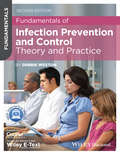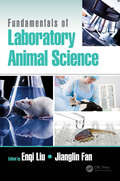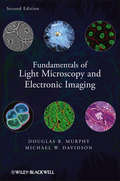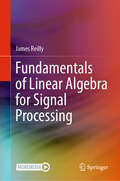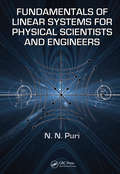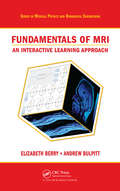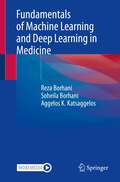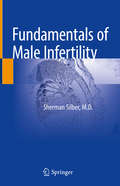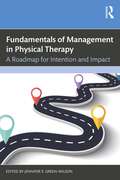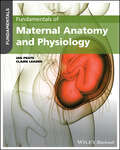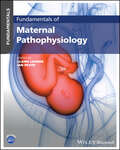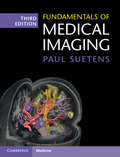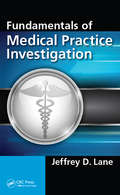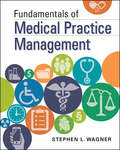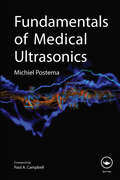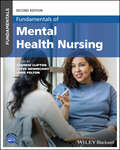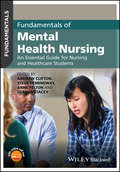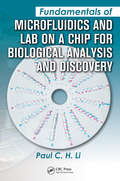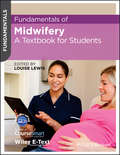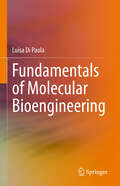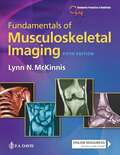- Table View
- List View
Fundamentals of Infection Prevention and Control
by Debbie WestonReviews of first edition:"This book tells every healthcare professional all they need to know about infection control... A user-friendly, valuable source of knowledge on a subject that can be confusing and complicated." Nursing Standard"A valuable contribution within any health or social environment." Journal of Community NursingInfection prevention and control is an essential component of nursing care, and a crucially important subject area for both nursing students and qualified nurses. Fundamentals of Infection Prevention and Control gives readers a firm grasp of the principles of infection control, how they relate to clinical practice and the key issues surrounding the subject. It provides a comprehensive guide to the prevention, management and control of healthcare associated infections, and the basic elements of microbiology, immunology and epidemiology that underpin them.Thoroughly revised in line with current policy, this new edition contains brand-new chapters on a range of topics including the role of the Infection Prevention and Control Team, audit and surveillance, and the management of outbreaks. Also incorporating a range of case studies and examples as well as additional online content, it is essential reading for all nursing students as well as qualified nursing and healthcare professionals.Explores both principles and practice of a crucial subject areaAccessible and user-friendly, with a range of features to help study including key definitions, links back to clinical practice, and chapter learning outcomes and summariesAccompanied by an online resource centre featuring MCQs, weblinks, case scenarios and downloadable fact sheetsFeatures an increased clinical focus, with more application to practiceThis title is also available:as a Wiley E-Text, powered by VitalSource: an interactive digital version of the book featuring downloadable text and images, highlighting and note-taking facilities, book-marking, cross-referencing, in-text searching, and linking to references and glossary termsinstantly on CourseSmart at www.coursesmart.co.uk/9781118306659. CourseSmart offers extrafunctionality, as well as an immediate way to review the text. For more details, visit www.coursesmart.com/instructors or www.coursesmart.com/students
Fundamentals of Inflammation
by Charles N. Serhan Peter A. Ward Derek W. Gilroy Charles N. Serhan Peter A. WardThe acute inflammatory response is the body's first system of alarm signals that are directed toward containment and elimination of microbial invaders. Uncontrolled inflammation has emerged as a pathophysiologic basis for many widely occurring diseases in the general population that were not initially known to be linked to the inflammatory response, including cardiovascular disease, asthma, arthritis, and cancer. To better manage treatment, diagnosis, and prevention of these wide-ranging diseases, multidisciplinary research efforts are underway in both academic and industry settings. This book provides an introduction to the cell types, chemical mediators, and general mechanisms of the host's first response to invasion. World-class experts from institutions around the world have written chapters for this introductory text. The text is presented as an introductory springboard for graduate students, medical scientists, and researchers from other disciplines wishing to gain an appreciation and working knowledge of current cellular and molecular mechanisms fundamental to inflammation.
Fundamentals of Laboratory Animal Science
by Enqi Liu and Jianglin FanLaboratory animals are becoming increasingly important for biomedical research. It is said that approximately 70% of biomedical research is associated with the use of experimental animals. Laboratory animal research not only expands our knowledge of science, but also greatly improves human and animal health. The field of laboratory animal science is ever-growing and changing as new experimental techniques are developed and new animal models are created. It is essential to know not only the biological features of each laboratory animal but also how to use and care for them responsibly in order to perform high-quality experiments. Courses in beginning Laboratory Animal Science are starting to be offered in many universities throughout the world. However, a practical introductory textbook that contains state-of-the-art techniques is still lacking. Fundamentals of Laboratory Animal Science provides comprehensive information on the principles and practices of using laboratory animals for biomedical research. Each individual chapter focuses on a key sub-discipline of laboratory animal science: animal welfare and best humane care practices in the laboratory; the quality control of laboratory animals; the anatomy, physiology, and husbandry of commonly used species; the principles of creating and using animal models for studying human diseases; practical techniques used for laboratory animal experiments; experimental design; and animal experimentation management. Knowledge of this broad spectrum of concepts and skills will ensure research goes smoothly while greatly reducing animal pain and distress. Well-illustrated and thoroughly referenced, this book will serve not only as a standard textbook but also as a handy guide for veterinarians, researchers, animal care staff, administrators, and other professionals who are involved in laboratory animal science.
Fundamentals of Light Microscopy and Electronic Imaging
by Douglas B. Murphy Michael W. DavidsonFundamentals of Light Microscopy and Electronic Imaging, Second Edition provides a coherent introduction to the principles and applications of the integrated optical microscope system, covering both theoretical and practical considerations. It expands and updates discussions of multi-spectral imaging, intensified digital cameras, signal colocalization, and uses of objectives, and offers guidance in the selection of microscopes and electronic cameras, as well as appropriate auxiliary optical systems and fluorescent tags.The book is divided into three sections covering optical principles in diffraction and image formation, basic modes of light microscopy, and components of modern electronic imaging systems and image processing operations. Each chapter introduces relevant theory, followed by descriptions of instrument alignment and image interpretation. This revision includes new chapters on live cell imaging, measurement of protein dynamics, deconvolution microscopy, and interference microscopy.PowerPoint slides of the figures as well as other supplementary materials for instructors are available at a companion website:www.wiley.com/go/murphy/lightmicroscopy
Fundamentals of Linear Algebra for Signal Processing
by James ReillySignal processing is ubiquitous in many fields of science and engineering. This textbook is tailored specifically for graduate students and presents linear algebra, which is requisite knowledge in these fields, in a form explicitly targeted to signal processing and related disciplines. Written by an experienced author with over 35 years of expertise in signal processing research and teaching, this book provides the necessary foundation in a focused and accessible manner, offering a practical approach to linear algebra without sacrificing rigor. Emphasis is placed on a deeper conceptualization of material specific to signal processing so students may more readily adapt this knowledge to actual problems in the field. Since other emerging areas, such as machine learning, are closely related to signal processing, the book also provides the necessary background in this discipline. The book includes many examples and problems relevant to signal processing, offering explanations and insights that are difficult to find elsewhere. Fundamentals of Linear Algebra for Signal Processing will allow students to master the essential knowledge of linear algebra for signal processing. It is also an essential guide for researchers and practitioners in biomedical, electrical, chemical engineering, and related disciplines.
Fundamentals of Linear Systems for Physical Scientists and Engineers
by N.N. PuriThanks to the advent of inexpensive computing, it is possible to analyze, compute, and develop results that were unthinkable in the '60s. Control systems, telecommunications, robotics, speech, vision, and digital signal processing are but a few examples of computing applications. While there are many excellent resources available that focus on one
Fundamentals of MRI: An Interactive Learning Approach (Series in Medical Physics and Biomedical Engineering)
by Elizabeth Berry Andrew J. BulpittFundamentals of MRI: An Interactive Learning Approach explores the physical principles that underpin the technique of magnetic resonance imaging (MRI).After covering background mathematics, physics, and digital imaging, the book presents fundamental physical principles, including magnetization and rotating reference frame. It describes how relaxation mechanisms help predict tissue contrast and how an MR signal is localized to a selected slice through the body. The text then focuses on frequency and phase encoding. It also explores the spin-echo sequence, its scan parameters, and additional imaging sequences, such as inversion recovery and gradient echo.The authors enhance the learning experience with practical materials. Along with questions, exercises, and solutions, they include ten interactive programs on the accompanying downloadable resources. These programs not only allow concepts to be clearly demonstrated and further developed, but also provide an opportunity to engage in the learning process through guided exercises.By providing a solid, hands-on foundation in the physics of MRI, this textbook helps students gain confidence with core concepts before they move on to further study or practical training.
Fundamentals of Machine Learning and Deep Learning in Medicine
by Reza Borhani Aggelos K. Katsaggelos Soheila BorhaniThis book provides an accessible introduction to the foundations of machine learning and deep learning in medicine for medical students, researchers, and professionals who are not necessarily initiated in advanced mathematics but yearn for a better understanding of this disruptive technology and its impact on medicine. Once an esoteric subject known to few outside of computer science and engineering departments, today artificial intelligence (AI) is a widely popular technology used by scholars from all across the academic universe. In particular, recent years have seen a great deal of interest in the AI subfields of machine learning and deep learning from researchers in medicine and life sciences, evidenced by the rapid growth in the number of articles published on the topic in peer-reviewed medical journals over the last decade. The demand for high-quality educational resources in this area has never been greater than it is today, and will only continue to grow at a rapid pace. Expert authors remove the veil of unnecessary complexity that often surrounds machine learning and deep learning by employing a narrative style that emphasizes intuition in place of abstract mathematical formalisms, allowing them to strike a delicate balance between practicality and theoretical rigor in service of facilitating the reader’s learning experience. Topics covered in the book include: mathematical encoding of medical data, linear regression and classification, nonlinear feature engineering, deep learning, convolutional and recurrent neural networks, and reinforcement learning. Each chapter ends with a collection of exercises for readers to practice and test their knowledge. This is an ideal introduction for medical students, professionals, and researchers interested in learning more about machine learning and deep learning. Readers who have taken at least one introductory mathematics course at the undergraduate-level (e.g., biostatistics or calculus) will be well-equipped to use this book without needing any additional prerequisites.
Fundamentals of Male Infertility
by Sherman SilberThis book analyzes the basic science and treatment of male factor infertility with Dr. Silber’s characteristic honesty and clear thinking. It describes finally what works and what doesn’t work. It will inspire everyone in reproductive medicine (Gynecologists, Urologists, Embryologists and Endocrinologists) who wish to better understand male infertility.
Fundamentals of Management in Physical Therapy: A Roadmap for Intention and Impact
by Green-Wilson, Jennifer E.Fundamentals of Management in Physical Therapy: A Roadmap for Intention and Impact helps to strengthen the development of transferable management skills and pragmatic business knowledge for physical therapists. This book will help physical therapist students, academic faculty, clinical faculty, adjunct faculty, and clinicians learn how to manage effectively at all levels and in a variety of diverse settings within the profession of physical therapy and within health care teams/organizations. Learners have multiple opportunities to reflect upon and apply practical and relevant information to build fundamental management skills that translate across settings.The book is a resource to help physical therapist assistants – as students and as practitioners – “manage up and across,” and to strengthen their ability to leverage high performing teams and value-based care.
Fundamentals of Maternal Anatomy and Physiology (Fundamentals)
by Ian Peate Claire LeaderFundamentals of Maternal Anatomy and Physiology An introduction to anatomy and physiology specifically tailored to the needs of midwives Existing resources often fall short in addressing the unique needs of midwives, focusing instead on broader healthcare perspectives. This book fulfils the demand for midwifery-specific knowledge in anatomy and physiology, offering a robust yet accessible introduction to key body systems. Fundamentals of Maternal Anatomy and Physiology ensures a thorough understanding of the subject matter with full-colour illustrations, from the intricacies of the placenta to the dynamics of the musculoskeletal and cardiac systems. Supported by the latest research and aligned with professional best practices, this book is an indispensable companion for both aspiring and seasoned midwives. It provides insight and understanding of maternal anatomy and physiology applied to midwifery practice. Suitable for undergraduate and postgraduate midwifery students, as well as midwives returning to practice, this resource is an invaluable asset in advancing anatomical and physiological knowledge within midwifery practice.
Fundamentals of Maternal Pathophysiology (Fundamentals)
by Ian Peate Claire LeaderFundamentals of Maternal Pathophysiology An introduction to pathophysiology specifically tailored to the needs of midwives Professional standards of proficiency require that midwives develop a robust understanding of pathophysiology, the study of disordered physical processes including disease and injury. This dedicated text equips both aspiring and registered midwives with the foundational understanding of pathophysiology required to deliver the best patient care. An understanding of pathophysiology is paramount for the delivery of safe and effective care during the various stages of pregnancy, childbirth and postpartum recovery. This understanding provides midwives with the insight to recognise and respond promptly to complications, fostering optimal outcomes for the mother and the newborn. Early recognition is pivotal, allowing for timely interventions that can significantly influence maternal and fetal well-being. A holistic approach to care is the cornerstone of midwifery and an understanding of pathophysiology allows midwives to consider the physical, emotional and social aspects of a woman’s health. This holistic perspective contributes to a more comprehensive and person-centred model of care. This user-friendly introduction is not only a foundational text but also a practical resource for practicing midwives. Informed by the latest research and reflective of current best practices, this book stands as an indispensable tool for this indispensable profession. Tailored for both undergraduate and graduate midwifery students, as well as registered midwives returning to practice, this resource is an invaluable asset in advancing pathophysiological knowledge within midwifery practice.
Fundamentals of Medical Imaging
by Paul SuetensFundamentals of Medical Imaging, Second Edition, provides an invaluable technical introduction to each imaging modality, explaining the mathematical and physical principles of medical imaging and image processing and giving the reader a clear understanding of how they are obtained and interpreted.
Fundamentals of Medical Imaging
by Paul SuetensFundamentals of Medical Imaging, second edition, is an invaluable technical introduction to each imaging modality, explaining the mathematical and physical principles and giving a clear understanding of how images are obtained and interpreted. Individual chapters cover each imaging modality – radiography, CT, MRI, nuclear medicine and ultrasound – reviewing the physics of the signal and its interaction with tissue, the image formation or reconstruction process, a discussion of image quality and equipment, clinical applications and biological effects and safety issues. Subsequent chapters review image analysis and visualization for diagnosis, treatment and surgery. New to this edition: • Appendix of questions and answers • New chapter on 3D image visualization • Advanced mathematical formulae in separate text boxes • Ancillary website containing 3D animations: www. cambridge. org/suetens • Full colour illustrations throughout Engineers, clinicians, mathematicians and physicists will find this an invaluable aid in understanding the physical principles of imaging and their clinical applications.
Fundamentals of Medical Practice Investigation
by Jeffrey D. LaneFundamentals of Medical Practice Investigation fills an important gap in the resources for criminal investigators. Appropriate for novice medical investigators as well as seasoned investigators looking to sharpen their skills, this book unites step-by-step fundamentals with up-to-date research reviews of critical issues in the field, including sexual misconduct, patient abuse, drug use among medical practitioners, and unethical or illegal prescription practices. An essential tool for law enforcement and other criminal justice professionals, Fundamentals of Medical Practice Investigation will improve the quality of all types of medical investigation.
Fundamentals of Medical Practice Management (Gateway to Healthcare Management)
by Stephen WagnerInstructor Resources: Instructor Manual and test bank.Consolidations and mergers have dramatically changed the face of the medical practice. From governance issues to information technology, today’s practice managers face a host of new complexities and competing priorities that demand more robust skills and knowledge than ever before.Fundamentals of Medical Practice Management uniquely addresses the educational needs of the modern practice manager. The author, who studied under quality guru W. Edwards Deming, combines a focus on quality and excellence with an important thesis: that working together and putting people first is the best path to success in healthcare. The author argues that win–lose games and quick-fix solutions have begun to deliver diminished returns in healthcare—not only economically but emotionally and societally. Although the book delves into many practical topics, its aim is to shape the reader’s mind-set for a new era of people-focused practice management.Fundamentals of Medical Practice Management covers these areas and more:• Information technology and management• Regulatory issues, law, and practice management• Strategic planning, project management, and marketing• Third-party payers and revenue cycle• Human resources management• Quality and emergency management This book will appeal to a wide range of learners, including those in organizational programs, undergraduate and master of health administration programs, and practice management certificate programs. Its insights will not only prepare those new to the field but also help current practice managers to retool and refocus.
Fundamentals of Medical Ultrasonics
by Michiel PostemaUltrasonic imaging is an economic, reliable diagnostic technique. Owing to recent therapeutic applications, understanding the physical principles of medical ultrasonics is becoming increasingly important. Covering the basics of elasticity, linear acoustics, wave propagation, nonlinear acoustics, transducer components, ultrasonic imaging modes, basi
Fundamentals of Medical-Surgical Nursing
by Catherine Mccabe Margaret Mccann Anne-Marie BradyFundamentals of Medical-Surgical Nursing: a Systems Approach is a comprehensive yet easy-to-read overview of medical and surgical nursing, designed specifically to support all nursing students learning to care for the adult patient. Highly illustrated and with an easy-to-follow systems-based structure, it provides a thorough foundation in anatomy and physiology, pathophysiology, medical management, and nursing care for the full spectrum of adult health conditions.Key features include:Extensive coverage of principles of nursing assessment, medication administration, infection prevention and control, and nutritional careKey need-to-know-information and definitions for the anatomy, physiology, and pathology of a range of illnesses and conditionsDetailed overviews of nursing care, including patient education, treatment, and complicationsAn online resource centre with a range of extras for both lecturers and students, including case studies, reflective activities, interactive multiple choice questions, and further reading listsFundamentals of Medical-Surgical Nursing: a Systems Approach is the ideal textbook to help students succeed on their adult nursing course.It is also available:as a Wiley E-Text, powered by VitalSource: an interactive digital version of the book featuring downloadable text and images, highlighting and note-taking facilities, book-marking, cross-referencing, in-text searching, and linking to references and glossary terms.instantly on CourseSmart at http://www.coursesmart.co.uk/9780470658239. CourseSmart offers extra functionality, as well as an immediate way to review the text. For more details, visit www.coursesmart.com/instructors or www.coursesmart.com/students.
Fundamentals of Mental Health Nursing (Fundamentals)
by Ian PeateEvidence-based introduction to the role of the mental health nurse, covering social, political, psychological, and biological aspects of mental health Fundamentals of Mental Health Nursing is an accessible, evidence-based introduction to the role of the mental health nurse, exploring the concepts of mental health and distress, ethics and accountability, key nursing models to be aware of, and the prevalence, predisposing factors, and features of the most commonly occurring mental health problems. This book places mental health conditions and interventions within a wider holistic context, situates recovery at the centre of mental health nursing practice, and links key concepts to mental health across the lifespan. This second edition contains revised content throughout as well as five new chapters on race, ethnicity, and diversity; sexuality, gender, and identity; global challenges for mental health; care planning in mental health; and transition to registration in leadership and resilience. Fundamentals of Mental Health Nursing includes: Different ways of defining mental health, and how different definitions can potentially ignore social factors that may influence health, such as povertySocial, political, and psychological factors that impact mental wellbeing and recovery, from cultural inequalities to poor housing, to trauma and cognitive behaviorBiological theory related to mental health, covering brain structure, neurochemistry, medication, and moreToday’s most common mental health problems including anxiety, mood disorders, psychosis, substance misuse, eating disorders, and organic disorders Fundamentals of Mental Health Nursing is a comprehensive and easy-to-understand reference on the subject for student nurses enrolled in pre-registration graduate nursing programmes, as well as early career nurses, nurses returning to practice, and healthcare assistants and assistant practitioners.
Fundamentals of Mental Health Nursing: An Essential Guide for Nursing and Healthcare Students
by Andrew Clifton Steve Hemingway Anne Felton Gemma StaceyFundamentals of Mental Health Nursing is an accessible evidence-based introduction to the role of the mental health nurse. This comprehensive overview explores concepts of mental health and distress, ethics and accountability, key nursing models to be aware of, and the prevalence, predisposing factors and features of the most commonly occurring mental health problems. KEY FEATURES: Places mental health conditions and interventions within a wider holistic context Situates Recovery at the centre of mental health nursing practice Links key concepts to mental health across the lifespan Contains learning outcomes in each chapter and includes scenarios and vignettes to root concepts in real-life practice Information is placed in a practice context from the outset, making this an essential guide to both the theory and the practice of mental health nursing. It is ideal for students on courses relating to mental health care, as well as for registered nurses and health care practitioners looking to revise their knowledge of key concepts.
Fundamentals of Microfluidics and Lab on a Chip for Biological Analysis and Discovery
by Paul C.H. LiLab-on-a-chip technology permits us to make many important discoveries that can only be observed at the microscale or the nanoscale. Using this technology, biological and biochemical analyses translate into greater sensitivity, more accurate results, and more valuable findings. Authored by one of the field's pioneering researchers, Fundamentals of
Fundamentals of Midwifery
by Louise LewisFundamentals of Midwifery: A Textbook for Students makes the subject of midwifery accessible, informative and motivating, ensuring that it is an essential text for the aspiring midwife!This resource brings together knowledge from a collection of clinical experts and experienced academics to support your learning and prepare you for the challenges faced in contemporary midwifery healthcare. It presents you with the 'must-have' information that you need concerning both the theoretical and practical aspects of what it means to be a midwife. With extensive full colour illustrations throughout, as well as activities and scenarios, this user-friendly textbook will support you throughout your entire education programme. Fundamentals of Midwifery is essential reading for all pre-registration student midwives, as well as newly qualified midwives.KEY FEATURES:* Broad and comprehensive in scope, with chapters on: team working; antenatal care, intrapartum and postnatal care; infant feeding; public health and health promotion; perinatal mental health; complementary therapies; pharmacology and medicines management; and emergencies.* Interactive and student-friendly in approach, with activities throughout.* Brings together professional and clinical topics in one user-friendly book.* Ties in with the latest NMC Standards for pre-registration midwifery education.* Supported by an online resource centre featuring interactive multiple-choice questions, additional scenarios and activities, and links to further reading.
Fundamentals of Midwifery: A Textbook for Students (Fundamentals)
by Louise LewisFundamentals of Midwifery: A Textbook for Students makes the subject of midwifery accessible, informative and motivating, ensuring that it is an essential text for the aspiring midwife! This resource brings together knowledge from a collection of clinical experts and experienced academics to support your learning and prepare you for the challenges faced in contemporary midwifery healthcare. It presents you with the ‘must-have’ information that you need concerning both the theoretical and practical aspects of what it means to be a midwife. With extensive full colour illustrations throughout, as well as activities and scenarios, this user-friendly textbook will support you throughout your entire education programme. Fundamentals of Midwifery is essential reading for all pre-registration student midwives, as well as newly qualified midwives. KEY FEATURES: • Broad and comprehensive in scope, with chapters on: team working; antenatal care, intrapartum and postnatal care; infant feeding; public health and health promotion; perinatal mental health; complementary therapies; pharmacology and medicines management; and emergencies. • Interactive and student-friendly in approach, with activities throughout. • Brings together professional and clinical topics in one user-friendly book. • Ties in with the latest NMC Standards for pre-registration midwifery education. • Supported by an online resource centre featuring interactive multiple-choice questions, additional scenarios and activities, and links to further reading.
Fundamentals of Molecular Bioengineering
by Luisa Di PaolaThis textbook covers the scientific basics of molecular bioengineering, a new field where technology meets biology and chemistry, and the fundamental knowledge required for students to understand molecular mechanisms beyond biological phenomena. The textbook focuses on the role of proteins in biomolecular machinery, and it is divided into 2 parts: Part I covers the molecular thermodynamics of biological systems, and Part II discusses the computational aspects behind protein structure prediction and molecular dynamics. In the first part of the textbook, students will find comprehensive explanations of thermodynamics and statistical mechanics, which are the basis to understand how molecular properties translate into macroscopic. Part I also offers an introduction to proteins and concepts like intermolecular forces, volumetric properties of fluids, ionization equilibria and salting-out, and protein binding and protein-protein interactions. In the second part of the textbook, students will learn about protein structure prediction and analysis, systems biology and structure-based protein networks, and computational tools and approaches for molecular dynamics simulations and protein binding and protein-protein interactions.This textbook adds to the scholarly debate with a unique contribution, addressing important new areas of biophysical chemistry and molecular biophysics not covered in currently available textbooks. Given its breadth, the textbook is suitable for courses in molecular biophysics, biochemistry, physical chemistry and bioengineering, and will also appeal to researchers and professionals in these fields.Part I of this book is a translation from its Italian original manuscript done with the help of artificial intelligence. A subsequent human revision of the content was done by the author. Springer Nature works continuously to further the development of tools for the production of books and on the related technologiesto support the authors.
Fundamentals of Musculoskeletal Imaging
by F. A. Davis Lynn N. McKinnisA volume in the Contemporary Perspectives in Rehabilitation Series Edited by Steven L. Wolf, PT, PhD, FAPTA The book that set the standard for the role of correlating imaging findings to clinical findings as part of a comprehensive patient evaluation, more specific treatment plans and better outcomes is back in a New Edition. <p><p>Here’s everything Physical Therapists need to know about medical imaging. This comprehensive guide helps you develop the skills and knowledge you need to accurately interpret imaging studies and understand written reports. Begin with a basic introduction to radiology; then progress to evaluating radiographs and advanced imaging from head to toe. Imaging for commonly seen traumas and pathologies, as well as case studies prepare you to meet the most common to most complex challenges in clinical and practice.
